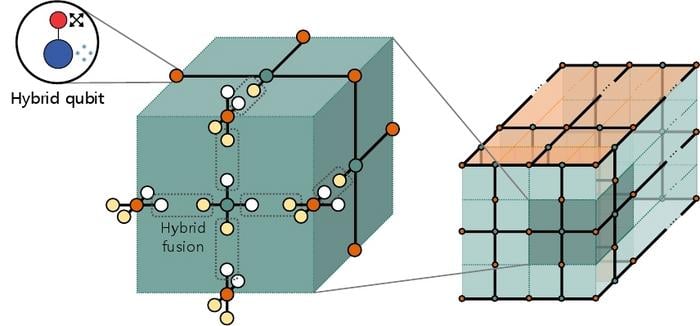Researchers have developed the world’s first hybrid quantum error correction technique, combining discrete and continuous variable approaches to improve quantum computing efficiency and effectiveness.
Summary: Scientists from KIST, University of Chicago, and Seoul National University have created a novel hybrid quantum error correction method that integrates discrete variable (DV) and continuous variable (CV) techniques, potentially revolutionizing quantum computing development.
Estimated reading time: 5 minutes
A team of international researchers has achieved a significant milestone in quantum computing development by creating the world’s first hybrid quantum error correction technique. This innovative approach combines discrete variable (DV) and continuous variable (CV) methods, potentially overcoming major hurdles in realizing practical quantum computers.
The Challenge of Quantum Error Correction
Quantum error correction is a critical technology for quantum computing. It addresses errors that occur in qubits, the basic units of quantum computation, preventing these errors from amplifying during computations. Without effective error correction, quantum computers cannot outperform classical computers, making this technology essential for advancing the field.
Dr. Seung-Woo Lee’s research team at the Korea Institute of Science and Technology (KIST)’s Quantum Technology Research Centre led the development of this groundbreaking hybrid technique. Their work not only integrates DV and CV error correction but also introduces a fault-tolerant quantum computing architecture based on this hybrid approach.
Advantages of the Hybrid Approach
The new hybrid quantum error correction technology offers several advantages:
- It combines the strengths of both DV and CV methods, which were previously developed separately.
- In optical quantum computing, it can achieve a photon loss threshold up to four times higher than existing techniques.
- It can improve resource efficiency by more than 13 times while maintaining the same level of logic error rate.
Dr. Jaehak Lee of KIST emphasized the versatility of this new technology, stating:
“The hybrid quantum error correction technology developed in this study can be combined not only with optical systems but also with superconductors and ion trap systems.”
Implications for Quantum Computing Development
This breakthrough has significant implications for the future of quantum computing. Dr. Seung-Woo Lee, who led the research, commented on its potential impact:
“This research provides a new direction for the development of quantum computing. Hybrid technologies that integrate the advantages of different platforms are expected to play a crucial role in developing and commercializing large-scale quantum computers.”
The development of this hybrid technique is particularly noteworthy given the current landscape of quantum computing research. Major tech companies are pursuing different approaches, with IBM, Google, Quera, and PsiQuantum developing quantum computers using the DV method, while Amazon (AWS) and Xanadu are adopting the CV method. This new hybrid approach could potentially bridge these different methodologies, leading to more efficient and effective quantum computers.
International Collaboration and Future Prospects
This breakthrough is the result of international collaboration between KIST, the University of Chicago, and Seoul National University. The research team achieved this important milestone just over a year after signing a memorandum of understanding (MOU) to collaborate on quantum technology research.
The rapid progress demonstrates the potential for developing core technologies that can lead the world in the highly competitive field of quantum computing. KIST is now hosting an international collaborative research centre focused on developing core technologies for quantum error correction, partnering with institutions including the University of Chicago, Seoul National University, and Canadian quantum computing company Xanadu.
As quantum computing continues to advance, this hybrid quantum error correction technology could play a pivotal role in realizing practical, large-scale quantum computers. By combining the strengths of different approaches, researchers are paving the way for more robust and efficient quantum systems that could revolutionize fields ranging from cryptography to drug discovery and beyond.
Quiz
- What is the main advantage of the new hybrid quantum error correction technique? a) It’s cheaper to implement b) It combines strengths of both DV and CV methods c) It only works with optical systems d) It eliminates all quantum errors
- How much can the new technique improve resource efficiency in optical quantum computing? a) Up to 2 times b) Up to 4 times c) More than 13 times d) Up to 100 times
- Which companies are developing quantum computers using the CV method? a) IBM and Google b) Quera and PsiQuantum c) Amazon (AWS) and Xanadu d) KIST and University of Chicago
Answers:
- b
- c
- c
Glossary of Terms
- Qubit: The basic unit of quantum computation, analogous to a classical bit.
- Quantum Error Correction: Technology to address and prevent errors in quantum computations.
- Discrete Variable (DV): A quantum computing approach using discrete states.
- Continuous Variable (CV): A quantum computing approach using continuous states.
- Fault-tolerant: Capable of operating correctly despite errors or faults.
- Photon Loss Threshold: The maximum amount of photon loss a quantum system can tolerate before failing.
Enjoy this story? Get our newsletter! https://scienceblog.substack.com/


